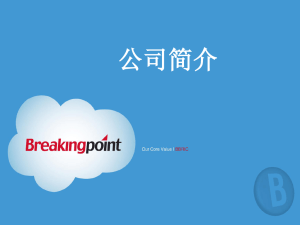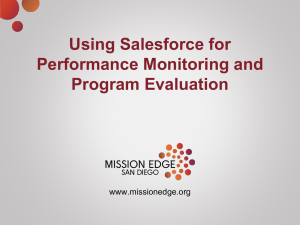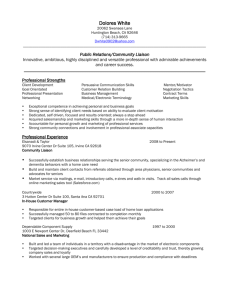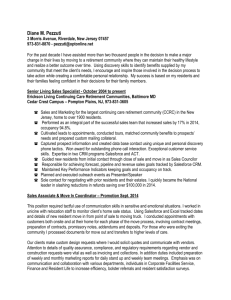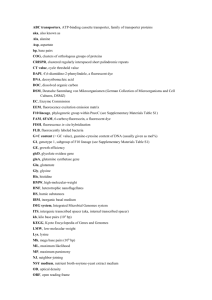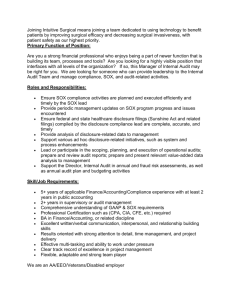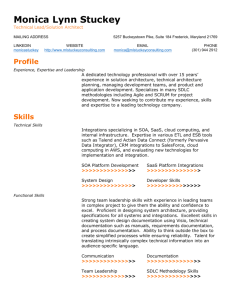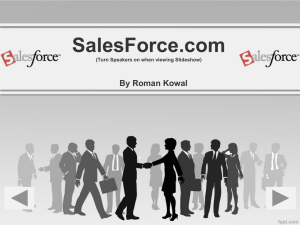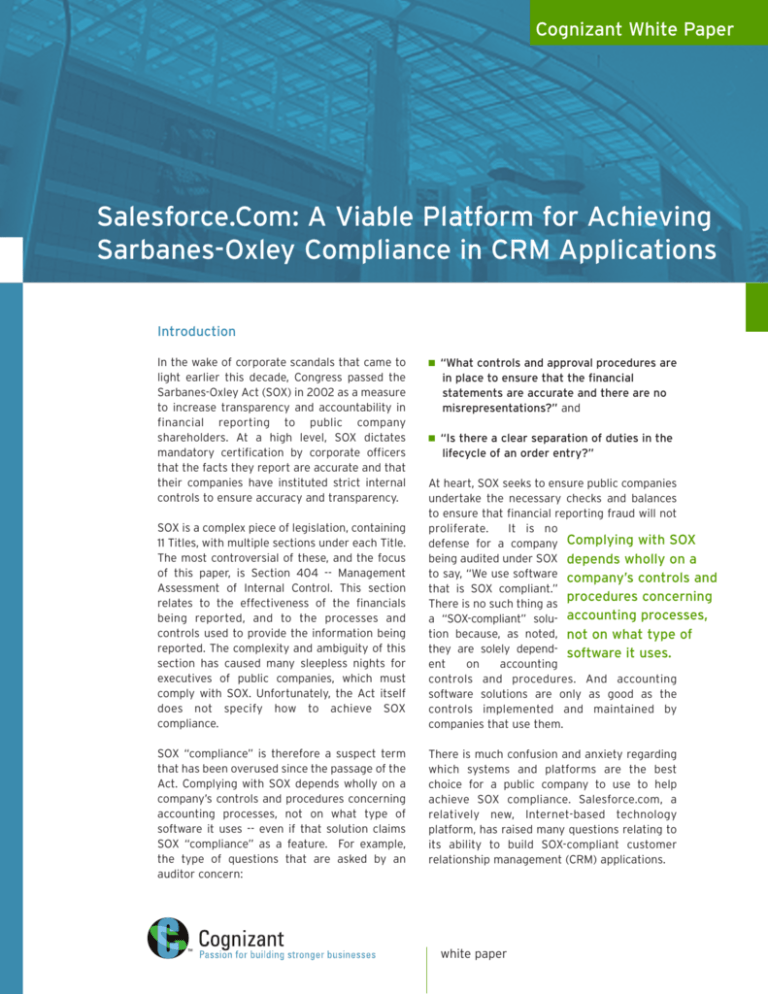
Cognizant White Paper
Salesforce.Com: A Viable Platform for Achieving
Sarbanes-Oxley Compliance in CRM Applications
Introduction
In the wake of corporate scandals that came to
light earlier this decade, Congress passed the
Sarbanes-Oxley Act (SOX) in 2002 as a measure
to increase transparency and accountability in
financial reporting to public company
shareholders. At a high level, SOX dictates
mandatory certification by corporate officers
that the facts they report are accurate and that
their companies have instituted strict internal
controls to ensure accuracy and transparency.
SOX is a complex piece of legislation, containing
11 Titles, with multiple sections under each Title.
The most controversial of these, and the focus
of this paper, is Section 404 -- Management
Assessment of Internal Control. This section
relates to the effectiveness of the financials
being reported, and to the processes and
controls used to provide the information being
reported. The complexity and ambiguity of this
section has caused many sleepless nights for
executives of public companies, which must
comply with SOX. Unfortunately, the Act itself
does not specify how to achieve SOX
compliance.
SOX “compliance” is therefore a suspect term
that has been overused since the passage of the
Act. Complying with SOX depends wholly on a
company’s controls and procedures concerning
accounting processes, not on what type of
software it uses -- even if that solution claims
SOX “compliance” as a feature. For example,
the type of questions that are asked by an
auditor concern:
“What controls and approval procedures are
in place to ensure that the financial
statements are accurate and there are no
misrepresentations?” and
“Is there a clear separation of duties in the
lifecycle of an order entry?”
At heart, SOX seeks to ensure public companies
undertake the necessary checks and balances
to ensure that financial reporting fraud will not
proliferate.
It is no
defense for a company Complying with SOX
being audited under SOX depends wholly on a
to say, “We use software company’s controls and
that is SOX compliant.”
procedures concerning
There is no such thing as
a “SOX-compliant” solu- accounting processes,
tion because, as noted, not on what type of
they are solely depend- software it uses.
ent
on
accounting
controls and procedures. And accounting
software solutions are only as good as the
controls implemented and maintained by
companies that use them.
There is much confusion and anxiety regarding
which systems and platforms are the best
choice for a public company to use to help
achieve SOX compliance. Salesforce.com, a
relatively new, Internet-based technology
platform, has raised many questions relating to
its ability to build SOX-compliant customer
relationship management (CRM) applications.
white paper
To begin with, Salesforce.com is a hosted
solution. Though the on-demand or Software as
a Service (SaaS) software delivery model is
becoming more prevalent due to its attractive
value proposition, most large enterprises do not
yet have much experience with it. These IT
managers have legitimate concerns about
placing their critical data off in the Internet
cloud, out of their immediate control. Finally,
since it is new, Salesforce.com’s development
platform is unfamiliar. So companies evaluating
the platform are naturally hesitant to embrace
new technologies without first understanding
the implications of building SOX-compliant
applications.
The objective of this white paper is to
demonstrate that Salesforce.com is one
platform that companies can use in conjunction
with the necessary internal policies and controls
to help achieve SOX compliance. But many of
the principles discussed here apply to other
CRM technology platforms, both on-demand
and on-premises. Other CRM vendors, including
Microsoft, SAP and Oracle have their
approaches to enabling SOX compliance. As
with Salesforce.com, these are only as good as
the client’s internal business processes and
controls. The truth is that rigorous application
of software development methodologies is
required for SOX compliance, no matter which
development software is used to build and
deliver the application.
The Myth of SOX-in-a-Box
While there are some generally accepted
practices and guidance for determining what is
effective in promoting SOX compliance, there
are no definitive black and whites.
In the Salesforce.com practice area at Cognizant,
our enterprise clients often ask, “Is
Salesforce.com Sarbanes-Oxley compliant?” In
reality, as mentioned in the introduction above,
no vendor’s system is SOX compliant “out of the
box.”
Since any computing platform is simply a tool
that reflects and manages key corporate
processes, a better question would be: “What
Salesforce.com features can help my
organization quickly implement the controls
mandated by SOX?”
2
While evaluating any software solution, the
focus should be on how it can help increase the
effectiveness of internal controls; reduce
material misrepresentation of risk; increase
transparency; and enforce the flow of
transactions, ensuring auditability, improving
record retention, and restricting unauthorized
changes. Much as one might wish it, there is no
“SOX-in-a-Box.”
When Does SOX Apply?
When evaluating technology platforms that may
serve as the foundation for achieving SOX
compliance, it is helpful first to determine the
types of enterprise data that are subject to SOX.
Unfortunately, this is not necessarily a
straightforward task. As with many other
aspects of the often-murky law, determining
whether or not a system is subject to SOX is
subject to interpretation. As a general rule,
systems that store, affect, and report on
“financially significant” transactions are within
the SOX purview. However, it is not always easy
to determine whether a system affects
“financially significant” applications.
In some cases, this is simple. At Cognizant’s
Salesforce.com practice, we have built many
applications on the Salesforce.com platform
that have little to do with
financial transactions. For As with many other
example, at a major insurance aspects of the oftencompany we implemented a murky law, determining
customer retention applicatwhether or not a system
ion whose sole purpose was
to facilitate the organization is subject to SOX is
of information related to subject to interpretation.
enterprise workflow by
proactively calling out at risk customers before
their contracts expired. Clearly, this system did
not need to comply with SOX mandates.
In fact, many Salesforce.com applications that
are either custom built using the vendor’s
powerful development platform or installed via
its Application Exchange environment are not
subject to SOX compliance.
At the other end of the spectrum, full-featured
GAAP-compliant accounting applications used
for financial reporting would need to be SOXaware. Oracle’s NetSuite.Com is one example.
white paper
The Evolving CRM Landscape
Connected
Communities
Connected
Enterprise
CRM 2.0
Web 2.0
Business Process Management
Workflow Automation
Application Integration
CDI / MDM
Traditional CRM
Customer Analytics
360 degree view
Sales / Service / Marketing
Operational and Predictive Analytics
Regulatory Data
Partners Data
Customer Data
Banks Data
Corporate Data
Vendor Data
Sales & Service Analytics
Cradle to Grave Analysis
Campaign & Channel Effectiveness
Product Performance
SLA Dashboards
Customer Behavior Analysis
Sales Planning
Campaign and Promotion
Customer Support
Lead & Demand Generation
Quota & Targeting
Resource Management
CRM Solutions Processes
Web Service Layer
Customers / Clients
Customer
Experience
Products
Figure 1
With the recent release of the robust
Salesforce.com on-demand development
platform, Cognizant expects to see a rapid rise
of standalone, pure-play accounting applications deployed on the Salesforce.com platform.
These will fall under SOX provisions.
The gray area between these two extremes
requires careful analysis. One example: Sales
order entry applications that originate as
financial data in Salesforce.com but are not the
official book of record. This data would include
sales compensation applications and asset and
inventory tracking applications that are
integrated with CRM systems.
Figure 1 depicts Cognizant’s view of the future
of CRM. It highlights the need for SOX diligence
when designing fully-integrated CRM systems.
Enterprise customers have complex integration
requirements. Many have turned to Cognizant
to leverage our proven ability to integrate CRM
systems with their back-office accounting
applications. Salesforce.com, in many cases, is
the de facto user interface into many backoffice applications. In that case, the best
practice is to assume SOX applies to all of the
data.
Salesforce.com CRM is often used to affect
future financial data. Products/price books,
contract management, revenue schedules, and
line items that ultimately are used for pipeline
forecasting are all potentially subject to SOX
interpretation, depending on how they are used.
For example, at a major publishing company,
Cognizant built a tightly integrated CRM system
that originates and then transmits all order
entry-related data to a back-office database
used for generating invoices. In this case, the
only user interface elements in the back-end
database pertain to generating billing
calculations and invoices.
Moreover, as CRM gains visibility and matures,
the lines between “financially significant”
accounting applications and traditional CRM are
blurring rapidly. The official financial data might
lie in a back-end “book of record” system and
officially be used for financial reporting, but
CRM is playing an ever-increasing role in
originating, organizing, searching, filtering, and
even reporting on financially significant data.
Therefore, due to ever-increasing overlap,
Cognizant advised that the publisher implement
Salesforce.com for all its CRM activities,
regardless of whether the individual function
was subject to SOX compliance. In any area
where it could be subject to SOX compliance, we
advocated erring on the conservative side, even
if analysis could technically yield a conclusion
that the implementation would not require it.
white paper
3
We feel that the controls mandated by SOX are
good practices for corporate IT even if various
components within this CRM system were not
originally considered necessary to being SOXcompliant. Meanwhile, the legislation spells out
certain requirements that companies must
meet at a minimum in order to be SOXcompliant.
Salesforce.com Features and SOX
Salesforce.com contains features that address
these SOX requirements. For example:
Protection of physical access to data.
One of the oft-cited concerns by companies
evaluating
on-demand
services
like
Salesforce.com is how to ensure the physical
security of their data residing outside the
firewall. After all, if one cannot assure the
protection of relevant data, then it will be
impossible to comply with SOX. The lack of
security in on-demand is a myth, one that it is
being debunked over time. Data is no less
secure when hosted on a vendor’s servers than
it is when accessed from a company’s own
infrastructure. In fact, the opposite is usually
true.
Salesforce.com has built a secure hosted
computing platform that far exceeds the
controls available at most private enterprises.
(See www.salesforce.com/security for more
information.) The company has spent tens of
millions of dollars in building a redundant,
mirrored,
totally
physically
secure
infrastructure that for-profit enterprises could
not achieve using their own internal IT
resources. Since its business model is built on a
multi-tenant architecture in which layered
servers are shared by thousands of companies,
physical security is at the top of
Salesforce.com’s priority list. A single breach
would irreparably damage the company’s
relationship with its large customer base.
Cognizant encourages all enterprise customers
evaluating Salesforce.com to visit one of
Salesforce.com’s impressive data centers to
tour the facilities and get a first-hand view of its
comprehensive, robust security provisions.
Role-based data access.
SOX requires that IT organizations take
4
white paper
measures to ensure their relevant financial data
is not tampered with for malicious purposes.
Controls against unauthorized access and use
of relevant data should be designed
independent of the technical platform. IT
organizations need to restrict access to
sensitive data to the personnel whose
professional roles legitimately require access.
Salesforce.com protects relevant data from
unauthorized access by using role-based
controls.
For example, a salesperson, a customer service
representative, an accounting user, and their
respective managers can all have different
access according to the level of data they need
to see.
Salesforce.com can also be set up to restrict
data access based on sales territory or different
job profiles for different departments.
Internal workflow controls to guard against
misuse of data by authorized users.
Robust, configurable workflow rules and
approval processes are two of the features that
function without the need for code-level
customization with Salesforce.com. These are
two very powerful features that allow an
organization to quickly implement and fine-tune
application-level controls to reduce the risk of
manipulative or fraudulent data coming into the
system.
In addition to its “out of the box” workflow
functionality, Salesforce.com also enables users
to create custom rules for workflow
management with triggers based on any
business event or period of time. These
workflow rules are easy to modify in response to
or in anticipation of changing business needs
and market developments.
Salesforce.com users can create multi-step
approvals to automate sales or business
processes that are distinct to their company,
such as discount requests or opportunity close
approvals.
In Cognizant’s Salesforce.com projects, we
implement a “gatekeeper” methodology to
ensure that data sent to back-end systems
passes through a robust approval process
implemented using Salesforce.com approval
functionality.
At the previously mentioned publishing
company, Cognizant implemented an advanced
framework of alerting managers any time
financially significant data is changed, as well as
a robust approval process for sending any
financial data to an external accounting system.
Any time a user attempts to enter or edit
financial data, an accounting specialist receives
an e-mail with a link to a pre-built custom report
that summarizes the subject activity. Only upon
an explicit approval by the specialist does the
system send the data to an integration server to
be synced to the “book of record.” These
controls provide multi-layered protection
against fraud.
Controls to guard against fraud once the
data is committed.
If financially significant data is needed in the
CRM system, as is increasingly the case, it needs
to be tightly controlled.
For example, at the publisher, the main focus of
the business is to retain existing customers who
subscribe to its enterprise content. Therefore, it
is critical to not only retain financially related
data, but take relevant action to ensure
continued customer success, ensure that
customers are renewing
In Cognizant’s their contracts, and introSalesforce.com projects, duce them to other digital
we implement a “gate- content offerings.
keeper” methodology to
ensure that data sent to
back-end systems passes
through a robust approval
process implemented
using Salesforce.com
approval functionality.
Therefore, it is critical that
the CRM system not only
originate financially related data, but also retain
it for monitoring. However,
from a data-management
perspective, existing data
can never be manipulated
directly; with the publisher,
this functionality was implemented using
Salesforce.com’s trigger-level validations
capabilities.
Ability to trace financially related data
throughout its lifecycle.
The ability to audit record histories is critically
important in achieving SOX compliance. In
Salesforce.com, this feature works immediately,
without customization, allowing an administrator
to set up field-level auditing within minutes. In a
system where SOX concerns are relevant, all
white paper
records affecting finance should be set up as an
audit fields.
Cognizant sets up field-level auditing not just on
currency-related fields, but prefers to enable
field-level auditing on all fields that pertain to a
customer order -- from contracts, billing
accounts, to order-level details.
Any time a user modifies any of the standard or
custom fields whose history is set to be tracked,
a new entry is added to the “History” list. All
entries include the date, time, nature and
originator, of the change.
Moreover, Salesforce.com encourages use of
histories in a subtle way: History data does not
count against an organization’s storage limit.
Cognizant’s enterprise customers are always
concerned about data storage costs of their
implementations; with Salesforce.com, fieldlevel auditing is not a concern.
In addition to field-level auditing, Salesforce.com
automatically logs all outbound e-mails sent
from the platform as permanent records of
communication. All tasks and events leave a
permanent trail. Although the platforms notes
are easily editable, Cognizant implements a
special comments function that is append-only;
comments are not editable once entered into
the system, ensuring yet another level of
security on record-level note taking.
One of the most important questions a SOX
auditor might ask during an evaluation is “Who
touched this record, when, and what did they
change?” Therefore, Cognizant advocates
robust contract, billing, and revenue-related
record retention and auditing controls for the
enterprise using Salesforce.com's built-in
capabilities.
Finally, we implement extensive integration
logging in our Salesforce.com engagements to
provide full traceability of data being sent to
back-end systems. Our custom electronic data
interchange (EDI) application used to integrate
Salesforce.com systems with enterprise backend servers utilizes the Salesforce.com API and
provides for robust integration logging.
Choosing an Implementation Partner
As advocated in this paper, SOX principles can
and should be applied to any CRM
implementation that involves financially
5
significant applications. Cognizant uses its
proprietary On-Demand Software Development
Lifecycle to implement this. Throughout the
cycle of gathering functional requirements,
technical requirements, and designing software
specifications, the Cognizant team evaluates
specifications for their impact on the data and
impact on internal controls, interfaces, and
security. Cognizant is ISO 9001 certified, a sign
of our serious commitment to quality.
Conclusion
The purpose of this paper has been to illustrate
that the most important step in achieving SOX
compliance is to deploy processes and controls
in the capture of functional requirements around
separation
of
duties,
identifying controls needed, Cognizant advocates
robust contract, billing,
and auditing requirements.
and revenue-related record
We dispelled the myth that
retention and auditing
any
system,
including
Salesforce.com, will short cut controls for the enterprise
the real work involved in using the platform’s builtworking toward SOX compli- in capabilities.
ance. If you are evaluating
Salesforce.com as a solution, you can be sure
that it does have the capability to implement
the required controls in a properly designed
system.
A Solutions Assurance Group should be set up
to independently monitor for SOX compliance.
At Cognizant, we have personnel that ensure
that our designs meet institutionalized best
practices surrounding regulatory compliance
and requirements traceability.
Though the use of the Salesforce.com platform
rapidly decreases total deployment time,
technology in and of itself is no substitute for
rigorous processes that extend from project
planning and solution design through
management and implementation. SOX risk is
reduced by ensuring that projects are taken
through the traditional development cycle,
albeit in a more rapid timeframe (see Figure 2).
A trusted partner like Cognizant can assist by
bringing best practices and an implementation
methodology that includes a collaborative
approach to requirements capture. Cognizant
also has implementation project management
tools that facilitate collaboration between the
Project Management Roadmap
Plan & Req. Elicitation
Implementation
& Testing
Solution Design
Project Kick-off
Design Workshop
Project Planning
Solution Design
Configuration
Customization
Deployment
and Roll-out
Product Migration
Integration
Roll-Out
Conference Room
Pilot 3 (CRP)
Business Process
Review (BPR)
Data Migration
Strategy
Conference Room
Pilot 1 (CRP)
Data Mapping
Final Implementation
Business Review
& Validation
Conference Room
Pilot 2 (CRP)
SIT
Business Review
& Validation
Training
UAT
Business Review
& Validation
Preparation of
User Training
Data Load - Sandbox
Project Management
Figure 2
white paper
6
Data Load-Production
customer and our onsite and offshore project teams to ensure that all design elements are jointly
built and approved as the system is developed. A trusted consulting partner that has captured
leading practices used in the client’s industry can speed the process of identifying the controls
needed. We use steering committees for the purpose of bringing forth these practices, and multiple
conference room pilots throughout the implementation cycle to ensure that representatives of the
user community are engaged early and often.
For more information:
Salesforce.com
www.salesforce.com
The Sarbanes-Oxley Act
http://frwebgate.access.gpo.gov/cgibin/getdoc.cgi?dbname=107_cong_bills&docid=f:h3763enr.tst.pdf
PCAOB Auditing Standard No. 5
http://www.pcaob.org/Rules/Docket_021/2007-05-24_Release_No_2007-005.pdf
SEC Interpretive Guide
http://www.sec.gov/rules/interp/2007/33-8810.pdf
This white paper was written by Mehmet Ergun, a senior manager in Cognizant’s Salesforce.com
consulting practice, who has engaged in leading SaaS implementations across Fortune 1,000
enterprises. Mehmet has been building enterprise-scale business applications since 1992 and has led
customers through multiple software design/build/deploy paradigm shifts, from the desktop to
client/server to the internet and now finally to the next frontier in business applications -- software
development within the SaaS architecture. He can be reached at Mehmet.Ergun@cognizant.com.
About Cognizant
Cognizant (NASDAQ: CTSH) is a leading provider of information technology, consulting and business process outsourcing services. Cognizant’s single-minded passion is to dedicate our global technology and innovation know-how, our industry expertise
and worldwide resources to working together with clients to make their businesses stronger. With more than 40 global delivery centers and 59,000 employees as of June 30, 2008, we combine a unique onsite/offshore delivery model infused by a distinct culture of customer satisfaction. A member of the NASDAQ-100 Index and S&P 500 Index, Cognizant is a Forbes Global
2000 company and a member of the Fortune 1000 and is ranked among the top information technology companies in
BusinessWeek’s Info Tech 100, Hot Growth and Top 50 Performers listings.
Start Today
For more information on how to maximize your customer relationship solutions with Cognizant, contact us at
inquiry@cognizant.com or visit our website at: www.cognizant.com.
World Headquarters
European Headquarters
India Operations Headquarters
500 Frank W. Burr Blvd.
Teaneck, NJ 07666 USA
Phone: +1 201 801 0233
Fax: +1 201 801 0243
Toll Free: +1 888 937 3277
Email: inquiry@cognizant.com
Haymarket House
28-29 Haymarket
London SW1Y 4SP UK
Phone: +44 (0) 20 7321 4888
Fax: +44 (0) 20 7321 4890
Email: infouk@cognizant.com
#5/535, Old Mahabalipuram Road
Okkiyam Pettai, Thoraipakkam
Chennai, 600 096 India
Phone: +91 (0) 44 4209 6000
Fax: +91 (0) 44 4209 6060
Email: inquiryindia@cognizant.com
© Copyright 2008, Cognizant. All rights reserved. No part of this document may be reproduced, stored in a retrieval system, transmitted in any form or by any means, electronic, mechanical, photocopying, recording, or
otherwise, without the express written permission from Cognizant. The information contained herein is subject to change without notice. All other trademarks mentioned herein are the property of their respective owners.

